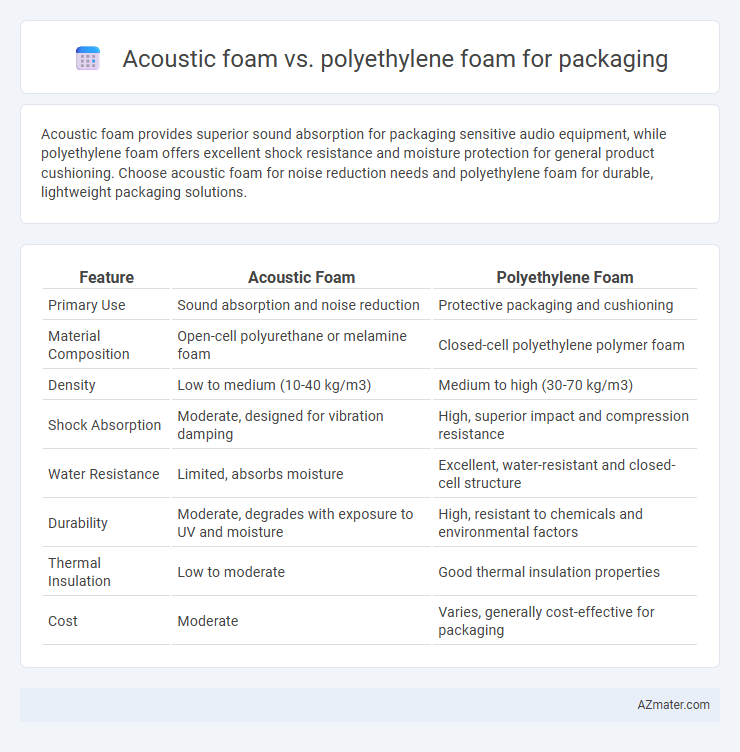Acoustic foam provides superior sound absorption for packaging sensitive audio equipment, while polyethylene foam offers excellent shock resistance and moisture protection for general product cushioning. Choose acoustic foam for noise reduction needs and polyethylene foam for durable, lightweight packaging solutions.
Table of Comparison
| Feature | Acoustic Foam | Polyethylene Foam |
|---|---|---|
| Primary Use | Sound absorption and noise reduction | Protective packaging and cushioning |
| Material Composition | Open-cell polyurethane or melamine foam | Closed-cell polyethylene polymer foam |
| Density | Low to medium (10-40 kg/m3) | Medium to high (30-70 kg/m3) |
| Shock Absorption | Moderate, designed for vibration damping | High, superior impact and compression resistance |
| Water Resistance | Limited, absorbs moisture | Excellent, water-resistant and closed-cell structure |
| Durability | Moderate, degrades with exposure to UV and moisture | High, resistant to chemicals and environmental factors |
| Thermal Insulation | Low to moderate | Good thermal insulation properties |
| Cost | Moderate | Varies, generally cost-effective for packaging |
Introduction: Comparing Acoustic Foam and Polyethylene Foam for Packaging
Acoustic foam and polyethylene foam serve distinct purposes in packaging, with acoustic foam primarily designed for sound absorption and polyethylene foam excelling in shock absorption and cushioning. Acoustic foam's open-cell structure reduces noise but offers moderate impact resistance, while polyethylene foam features a closed-cell design that provides superior protection against mechanical damage, moisture, and chemicals. Selecting the appropriate foam depends on the packaging requirements, including vibration isolation, protection level, and environmental exposure.
Material Composition and Structure
Acoustic foam is typically made from open-cell polyurethane or melamine, featuring a porous structure that absorbs sound waves by trapping air within its network of interconnected cells. Polyethylene foam consists of closed-cell polyethylene, creating a dense, resilient structure that provides excellent cushioning and impact resistance for packaging applications. The difference in material composition and cell structure directly impacts their performance, with acoustic foam optimized for sound dampening and polyethylene foam designed for shock absorption and physical protection.
Protective Performance and Shock Absorption
Acoustic foam provides excellent noise reduction but has limited protective performance and shock absorption compared to polyethylene foam, which excels in impact resistance and cushioning for packaging applications. Polyethylene foam offers superior energy absorption characteristics, making it ideal for protecting fragile items during transit through its closed-cell structure. The durability and resilience of polyethylene foam significantly outperform acoustic foam in preventing damage from drops and vibrations.
Compressibility and Flexibility
Acoustic foam exhibits high compressibility and flexibility, making it ideal for cushioning delicate items by absorbing shocks and vibrations during transit. Polyethylene foam offers moderate compressibility with superior durability and resilience, providing firm support and maintaining shape under heavy loads. These properties make acoustic foam preferable for fragile packaging, while polyethylene foam suits applications requiring sturdier protection and repetitive impact resistance.
Weight and Density Considerations
Acoustic foam typically features lower density and lighter weight compared to polyethylene foam, making it suitable for applications needing sound absorption without adding bulk. Polyethylene foam offers higher density, providing greater cushioning and protection in packaging while contributing to increased weight. Selecting between the two depends on balancing the need for lightweight materials with protective performance based on specific packaging requirements.
Moisture and Chemical Resistance
Polyethylene foam offers superior moisture resistance compared to acoustic foam, making it ideal for packaging applications where exposure to water or humidity is a concern. Chemical resistance is also significantly better in polyethylene foam, providing protection against oils, solvents, and other industrial chemicals that may compromise packaging integrity. Acoustic foam, while effective for sound absorption, tends to absorb moisture and is less resistant to chemical exposure, limiting its use in environments requiring robust protective barriers.
Cost and Availability
Polyethylene foam is generally more cost-effective and widely available for packaging due to its mass production and usage in various industries. Acoustic foam tends to be pricier because of its specialized design for sound absorption and is less commonly stocked by general packaging suppliers. Companies seeking economical, readily accessible cushioning often prefer polyethylene foam over acoustic foam for protective packaging solutions.
Environmental Impact and Recyclability
Acoustic foam, often made from polyurethane or melamine, has limited recyclability and can release harmful chemicals during degradation, posing environmental challenges. Polyethylene foam, derived from a more stable polymer, offers better recyclability through established plastic recycling streams, reducing environmental impact. Choosing polyethylene foam for packaging supports sustainability goals due to its lower ecological footprint and greater potential for reuse.
Industry Applications and Use Cases
Acoustic foam is primarily used in packaging sensitive audio equipment and musical instruments due to its sound absorption properties, reducing vibrations and preventing damage during transport. Polyethylene foam offers superior impact resistance and cushioning, making it ideal for heavy machinery, electronics, and fragile industrial components in shipping and storage. Both materials enhance product protection in different industry applications, with acoustic foam tailored for noise-sensitive items and polyethylene foam favored for its durability and moisture resistance.
Choosing the Right Foam for Your Packaging Needs
Selecting between acoustic foam and polyethylene foam for packaging depends on the primary protection requirements and environmental conditions. Acoustic foam excels in sound absorption and cushioning delicate electronic components, while polyethylene foam offers superior impact resistance, water resistance, and durability ideal for heavy-duty shipments. Understanding product fragility, transportation risks, and moisture exposure ensures the right foam choice enhances protection and reduces damage during transit.

Infographic: Acoustic foam vs Polyethylene foam for Packaging
 azmater.com
azmater.com